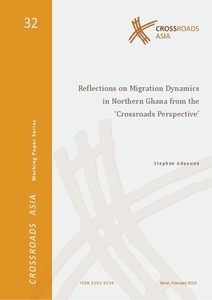Adaawen, Stephen: Reflections on Migration Dynamics in Northern Ghana from the ‘Crossroads Perspective’. Bonn: Competence Network Crossroads Asia: Conflict – Migration – Development, 2016. In: Baldauf, Ingeborg; Conermann, Stephan; Kreutzmann, Hermann; Nadjmabadi, Shahnaz; Reetz, Dietrich; Schetter, Conrad; Sökefeld, Martin; Bech Hansen, Claus Erik; Hornidge, Anna-Katharina; Nokkala, Nelli; Mielke, Katja (Hrsg.): Crossroads Asia Working Paper Series, 32.
Online-Ausgabe in bonndoc: https://hdl.handle.net/20.500.11811/167
Online-Ausgabe in bonndoc: https://hdl.handle.net/20.500.11811/167
@techreport{handle:20.500.11811/167,
author = {{Stephen Adaawen}},
editor = {{Ingeborg Baldauf} and {Stephan Conermann} and {Hermann Kreutzmann} and {Shahnaz Nadjmabadi} and {Dietrich Reetz} and {Conrad Schetter} and {Martin Sökefeld} and {Claus Erik Bech Hansen} and {Anna-Katharina Hornidge} and {Nelli Nokkala} and {Katja Mielke}},
title = {Reflections on Migration Dynamics in Northern Ghana from the ‘Crossroads Perspective’},
publisher = {Competence Network Crossroads Asia: Conflict – Migration – Development},
year = 2016,
month = feb,
series = {Crossroads Asia Working Paper Series},
volume = 32,
note = {The paper analyses mobility patterns in Northern Ghana while reflecting also on my ‘positionality’ as researcher from the area thus critically analysing mobility patterns and processes of negotiating social boundaries and construction of space within the context of Northern Ghana. The foregoing discussion has sought to reflect on migration dynamics and flows in Northern Ghana. The constant flows of people, goods, symbols and new ideas from the south and other parts of the country can be seen to have contributed to social transformation and also provided the basis for social mobility and the negotiation of social boundaries in rural communities. In particular, the integration of new symbols of what is considered as success and social practices transferred from the south as much more institutionalised socio-cultural practices in most communities of Northern Ghana signifies the changing collective identities and social imaginaries of people. It also shows how – through mobility processes – different social realities and symbols transcend social, cultural and physio-spatial boundaries (in this case from Southern to Northern Ghana). This brings into question widespread perceptions of rural communities in Northern Ghana as areas which are spatially inaccessible, culturally homogenous, and conservative to change.},
url = {https://hdl.handle.net/20.500.11811/167}
}
author = {{Stephen Adaawen}},
editor = {{Ingeborg Baldauf} and {Stephan Conermann} and {Hermann Kreutzmann} and {Shahnaz Nadjmabadi} and {Dietrich Reetz} and {Conrad Schetter} and {Martin Sökefeld} and {Claus Erik Bech Hansen} and {Anna-Katharina Hornidge} and {Nelli Nokkala} and {Katja Mielke}},
title = {Reflections on Migration Dynamics in Northern Ghana from the ‘Crossroads Perspective’},
publisher = {Competence Network Crossroads Asia: Conflict – Migration – Development},
year = 2016,
month = feb,
series = {Crossroads Asia Working Paper Series},
volume = 32,
note = {The paper analyses mobility patterns in Northern Ghana while reflecting also on my ‘positionality’ as researcher from the area thus critically analysing mobility patterns and processes of negotiating social boundaries and construction of space within the context of Northern Ghana. The foregoing discussion has sought to reflect on migration dynamics and flows in Northern Ghana. The constant flows of people, goods, symbols and new ideas from the south and other parts of the country can be seen to have contributed to social transformation and also provided the basis for social mobility and the negotiation of social boundaries in rural communities. In particular, the integration of new symbols of what is considered as success and social practices transferred from the south as much more institutionalised socio-cultural practices in most communities of Northern Ghana signifies the changing collective identities and social imaginaries of people. It also shows how – through mobility processes – different social realities and symbols transcend social, cultural and physio-spatial boundaries (in this case from Southern to Northern Ghana). This brings into question widespread perceptions of rural communities in Northern Ghana as areas which are spatially inaccessible, culturally homogenous, and conservative to change.},
url = {https://hdl.handle.net/20.500.11811/167}
}






